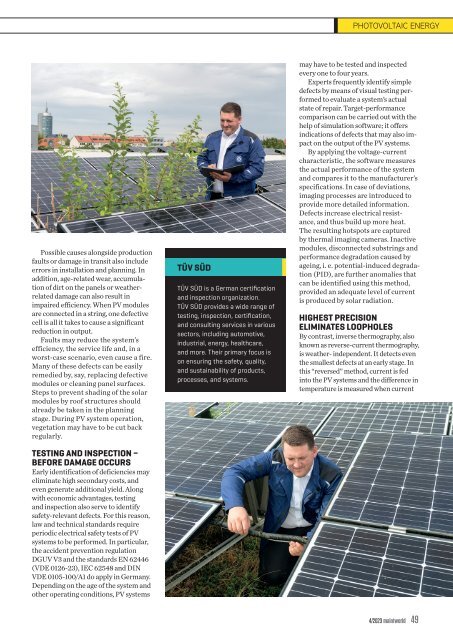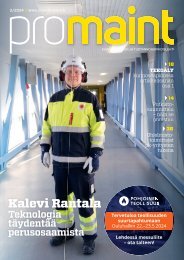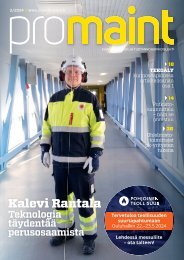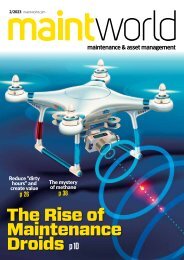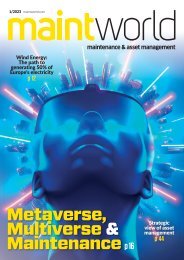Maintworld Magazine 4/2023
- maintenance & asset management
- maintenance & asset management
Create successful ePaper yourself
Turn your PDF publications into a flip-book with our unique Google optimized e-Paper software.
PHOTOVOLTAIC ENERGY<br />
Possible causes alongside production<br />
faults or damage in transit also include<br />
errors in installation and planning. In<br />
addition, age-related wear, accumulation<br />
of dirt on the panels or weatherrelated<br />
damage can also result in<br />
impaired efficiency. When PV modules<br />
are connected in a string, one defective<br />
cell is all it takes to cause a significant<br />
reduction in output.<br />
Faults may reduce the system’s<br />
efficiency, the service life and, in a<br />
worst-case scenario, even cause a fire.<br />
Many of these defects can be easily<br />
remedied by, say, replacing defective<br />
modules or cleaning panel surfaces.<br />
Steps to prevent shading of the solar<br />
modules by roof structures should<br />
already be taken in the planning<br />
stage. During PV system operation,<br />
vegetation may have to be cut back<br />
regularly.<br />
TESTING AND INSPECTION –<br />
BEFORE DAMAGE OCCURS<br />
Early identification of deficiencies may<br />
eliminate high secondary costs, and<br />
even generate additional yield. Along<br />
with economic advantages, testing<br />
and inspection also serve to identify<br />
safety-relevant defects. For this reason,<br />
law and technical standards require<br />
periodic electrical safety tests of PV<br />
systems to be performed. In particular,<br />
the accident prevention regulation<br />
DGUV V3 and the standards EN 62446<br />
(VDE 0126-23), IEC 62548 and DIN<br />
VDE 0105-100/A1 do apply in Germany.<br />
Depending on the age of the system and<br />
other operating conditions, PV systems<br />
TÜV SÜD<br />
TÜV SÜD is a German certification<br />
and inspection organization.<br />
TÜV SÜD provides a wide range of<br />
testing, inspection, certification,<br />
and consulting services in various<br />
sectors, including automotive,<br />
industrial, energy, healthcare,<br />
and more. Their primary focus is<br />
on ensuring the safety, quality,<br />
and sustainability of products,<br />
processes, and systems.<br />
may have to be tested and inspected<br />
every one to four years.<br />
Experts frequently identify simple<br />
defects by means of visual testing performed<br />
to evaluate a system’s actual<br />
state of repair. Target-performance<br />
comparison can be carried out with the<br />
help of simulation software; it offers<br />
indications of defects that may also impact<br />
on the output of the PV systems.<br />
By applying the voltage-current<br />
characteristic, the software measures<br />
the actual performance of the system<br />
and compares it to the manufacturer’s<br />
specifications. In case of deviations,<br />
imaging processes are introduced to<br />
provide more detailed information.<br />
Defects increase electrical resistance,<br />
and thus build up more heat.<br />
The resulting hotspots are captured<br />
by thermal imaging cameras. Inactive<br />
modules, disconnected substrings and<br />
performance degradation caused by<br />
ageing, i. e. potential-induced degradation<br />
(PID), are further anomalies that<br />
can be identified using this method,<br />
provided an adequate level of current<br />
is produced by solar radiation.<br />
HIGHEST PRECISION<br />
ELIMINATES LOOPHOLES<br />
By contrast, inverse thermography, also<br />
known as reverse-current thermography,<br />
is weather- independent. It detects even<br />
the smallest defects at an early stage. In<br />
this “reversed” method, current is fed<br />
into the PV systems and the difference in<br />
temperature is measured when current<br />
4/<strong>2023</strong> maintworld 49


